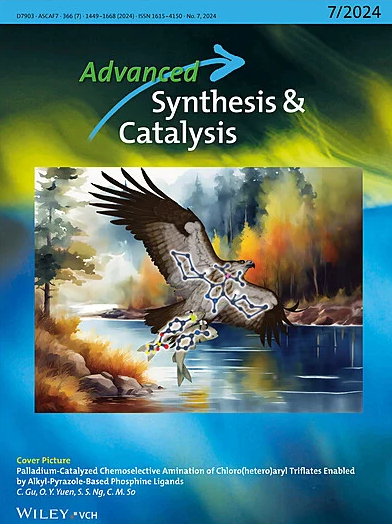Transition Metal‐Catalyzed Directing Group‐Assisted Site‐Selective Di‐ortho C−H Functionalizations via Double C−H Activation
IF 4.4
2区 化学
Q2 CHEMISTRY, APPLIED
引用次数: 0
Abstract
The directing group (DG)‐assisted transition metal (TM)‐catalyzed site‐selective C−H activation and functionalization has become a popular approach in the synthesis of natural products, pharmaceuticals, and late‐stage functionalization. In particular the ortho‐selective C−H functionalization is frequently addressed. One DG generally directs the mono‐C−H functionalization. However, over the years there are some exceptional reactions have been reported where one DG directs di‐ortho‐C−H functionalization offering extra functionalization in one‐pot. There is no generalization in this type of reactions. In this comprehensive report, we have summarized the di‐ortho‐C−H functionalization reactions reported in the recent two decades (2004‐2024) and provided the current status and future perspective for further modifications. This discussion covers DG‐assisted site‐selective di‐ortho‐Arylation, di‐ortho‐alkylation, di‐ortho‐Alkenylation, di‐ortho‐alkynylation, di‐ortho‐cyanation, di‐ortho‐amination, di‐ortho‐thiolation/selenation, di‐ortho‐carbonylation, di‐ortho‐halogenation, di‐ortho‐oxygenation, and unsymmetrical di‐ortho C‐H functionalization of inert aryl and heteroaryl C−H bonds.通过双C - H活化,过渡金属催化定向基团辅助位点选择性二邻位C - H功能化
定向基团(DG)辅助过渡金属(TM)催化的位点选择性C - H活化和功能化已成为天然产物、药物合成和后期功能化的一种流行方法。特别是邻选择性C - H功能化经常被解决。一个DG通常指导单- C - H功能化。然而,多年来有一些特殊的反应被报道,其中一个DG直接二邻位C - H官能化,在一个锅中提供额外的官能化。在这类反应中没有泛化。在这篇综合报告中,我们总结了近二十年(2004 - 2024)报道的二邻位C−H功能化反应,并提供了进一步修改的现状和未来展望。本次讨论涵盖了DG辅助位点选择性二邻芳基化、二邻烷基化、二邻烯基化、二邻炔基化、二邻氰化、二邻胺化、二邻硫酰化/硒化、二邻羰基化、二邻卤化、二邻氧化,以及惰性芳基和杂芳基C - H键的非对称二邻C - H功能化。
本文章由计算机程序翻译,如有差异,请以英文原文为准。
求助全文
约1分钟内获得全文
求助全文
来源期刊

Advanced Synthesis & Catalysis
化学-应用化学
CiteScore
9.40
自引率
7.40%
发文量
447
审稿时长
1.8 months
期刊介绍:
Advanced Synthesis & Catalysis (ASC) is the leading primary journal in organic, organometallic, and applied chemistry.
The high impact of ASC can be attributed to the unique focus of the journal, which publishes exciting new results from academic and industrial labs on efficient, practical, and environmentally friendly organic synthesis. While homogeneous, heterogeneous, organic, and enzyme catalysis are key technologies to achieve green synthesis, significant contributions to the same goal by synthesis design, reaction techniques, flow chemistry, and continuous processing, multiphase catalysis, green solvents, catalyst immobilization, and recycling, separation science, and process development are also featured in ASC. The Aims and Scope can be found in the Notice to Authors or on the first page of the table of contents in every issue.
 求助内容:
求助内容: 应助结果提醒方式:
应助结果提醒方式:


